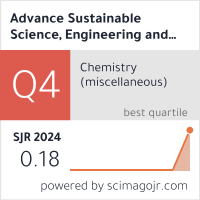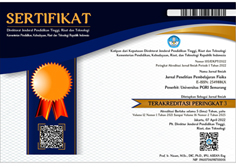Digital Transformation of Import Logistics for Operational Efficiency: Case-Based Evidence from the Plastics Industry
DOI:
https://doi.org/10.26877/asset.v7i3.1967Keywords:
IoT, Blockchain, Cost, Direct Delivery, Real-time VisibilityAbstract
This study aims to explore the use of digital systems to reduce import process costs, increase the percentage of national direct deliveries from ports to consumers, and analyze the impact of proposed improvement measures. The research employs a single case study approach with data collected through observation, document analysis, and quantitative data collection from one of the biggest plastic resin distribution companies in Indonesia. The data were analyzed using the CIMO (Context-Intervention-Mechanism-Outcome) logic to understand the context and impact of the interventions implemented. The findings reveal that the application of digital technologies such as the Internet of Things (IoT), Blockchain, and cloud-based management systems with real-time container tracking digital applications can optimize supply chain processes and sustainability. There was a notable reduction in the national average container storage costs at ports from $2.4/Ton to $1.8/Ton and an increase in the average percentage of national direct deliveries from ports to consumers from 17.3% to 22.0% before and after the implementation of the container tracking system. These results confirm that adopting digital technologies in plastic resin distribution companies not only improves operational efficiency, provides a competitive advantage in the market but also reduces carbon emission by using single trip directly to customers. Companies are advised to enhance employee training related to new technologies and adopt integrated systems within supply chain processes. Furthermore, continuous innovation using technologies such as artificial intelligence is essential for maintaining industry competitiveness and sustainability.
References
[1] Ľ. Kubíková and S. Rudý, “The Current Global Situation of Plastics and Forecast of Plastic Waste,” pp. 128–137, 2024, doi: 10.53465/edamba.2023.9788022551274.128-137.
[2] D. J. Teece, “Business models and dynamic capabilities,” Long Range Plann., vol. 51, no. 1, pp. 40–49, 2018, doi: 10.1016/j.lrp.2017.06.007.
[3] H. Fatorachian and H. Kazemi, “A critical investigation of Industry 4 . 0 in manufacturing : Theoretical operationalization framework Hajar Fatorachian , Hadi Kazemi,” Prod. Plan. Control., vol. 29, no. 8, pp. 1–40, 2018.
[4] S. Demir, I. Yilmaz, and T. Paksoy, Augmented Reality in Supply Chain Management, no. March. 2020. doi: 10.1201/9780429327636-14.
[5] X. Wang, V. Kumar, A. Kumari, and E. Kuzmin, “Impact of Digital Technology on Supply Chain Efficiency in Manufacturing Industry,” Lect. Notes Inf. Syst. Organ., vol. 54, no. April, pp. 347–371, 2022, doi: 10.1007/978-3-030-94617-3_25.
[6] A. Haddud and A. Khare, “Digitalizing supply chains potential benefits and impact on lean operations,” Int. J. Lean Six Sigma, vol. 11, no. 4, pp. 731–765, 2020, doi: 10.1108/IJLSS-03-2019-0026.
[7] M. Akbari and J. L. Hopkins, “Digital technologies as enablers of supply chain sustainability in an emerging economy,” Oper. Manag. Res., vol. 15, no. 3–4, pp. 689–710, 2022, doi: 10.1007/s12063-021-00226-8.
[8] X. Feng, R. Song, W. Yin, X. Yin, and R. Zhang, “Multimodal transportation network with cargo containerization technology: Advantages and challenges,” Transp. Policy, vol. 132, pp. 128–143, 2023, doi: https://doi.org/10.1016/j.tranpol.2022.12.006.
[9] R. K. Yin, Case study research and applications: Design and methods, 6th ed. Sage Publication, 2017.
[10] D. Denyer, D. Tranfield, and J. E. Van Aken, “Developing design propositions through research synthesis,” Organ. Stud., vol. 29, no. 3, pp. 393–413, 2008, doi: 10.1177/0170840607088020.
[11] S. Kvale, S., & Brinkmann, InterViews: Learning the craft of qualitative research interviewing, 2nd ed. SAGE Publications, 2009.
[12] J. W. Creswell, Qualitative inquiry and research design: Choosing among five approaches, 3rd ed. SAGE Publications, 2013.
[13] G. A. Bowe, “Document Analysis as a Qualitative Research Method,” Qual. Res. J., vol. 9, no. 2, pp. 27–40, 2009, [Online]. Available: doi:10.3316/qrj0902027
[14] R. Kalaiarasan, T. K. Agrawal, J. Olhager, M. Wiktorsson, and J. B. Hauge, “Supply chain visibility for improving inbound logistics: a design science approach,” Int. J. Prod. Res., vol. 61, no. 15, pp. 5228–5243, 2023, doi: 10.1080/00207543.2022.2099321.
[15] David S. Moore., G. P. McCabe, and C. B. A., Introduction to The Practice of Statistics, Sixth. 2009.
[16] D. M. Jessusek and D. H. Volk-Jessuses, Statistics Made Easy, 6th ed. DATAtab e.U, 2025.
[17] P. Goel, “Triple Bottom Line Reporting: An Analytical Approach for Corporate Sustainability.,” J. Financ. Account. Manag., vol. 1, no. 1, 2010.
[18] A. M. Arifai and M. F. Arsyad, “Urban Expansion , Climate Vulnerability , and Transportation Resilience : Insights for Sustainable Development,” vol. 7, no. 2, pp. 1–12, 2025.
[19] Haswika, Agus Mansur, and Meilinda F. N. Maghfiroh, “Risk Mitigation Strategies for Sustainable Poultry Supply Chain Management,” Adv. Sustain. Sci. Eng. Technol., vol. 6, no. 4, p. 02403011, 2024, doi: 10.26877/asset.v6i4.997.
[20] A. Calatayud, J. Mangan, and M. Christopher, “The self-thinking supply chain,” Supply Chain Manag. An Int. J., vol. 24, no. 1, pp. 22–38, Jan. 2019, doi: 10.1108/SCM-03-2018-0136.
[21] M. Ben-Daya, E. Hassini, and Z. Bahroun, “Internet of things and supply chain management: a literature review,” Int. J. Prod. Res., vol. 57, no. 15–16, pp. 4719–4742, 2019, doi: 10.1080/00207543.2017.1402140.
[22] M. Giannakis, K. Spanaki, and R. Dubey, “A cloud-based supply chain management system: effects on supply chain responsiveness,” J. Enterp. Inf. Manag., vol. 32, no. 4, pp. 585–607, Jan. 2019, doi: 10.1108/JEIM-05-2018-0106.
[23] S. N. Rajan, P. Sharma, D. Srivastava, K. Koul, S. Aluvala, and Shashikant, “An Advanced Container Tracking System for Real-Time Monitoring and Automated Alerting of Container Security and Logistics,” in 2024 3rd International Conference on Sentiment Analysis and Deep Learning (ICSADL), 2024, pp. 581–586. doi: 10.1109/ICSADL61749.2024.00100.
[24] A. Brun, H. Karaosman, and T. Barresi, “Supply chain collaboration for transparency,” Sustain., vol. 12, no. 11, 2020, doi: 10.3390/su12114429.
[25] Masdiana et al., Revolusi Plastik dan lingkungan. Makassar: CV. Tohar Media, 2023. [Online]. Available: https://repository.unifa.ac.id/id/eprint/1133/1/13. EBOOK PLASTIK_compressed.pdf
[26] J. A. G. Gandía, S. G. Gavrila, A. De Lucas Ancillo, and M. T. Del Val Núñez, “RPA as a Challenge Beyond Technology: Self-Learning and Attitude Needed for Successful RPA Implementation in the Workplace,” J. Knowl. Econ., 2024, doi: 10.1007/s13132-024-01865-5.
[27] H. Kusumo, D. Marlina, and A. Solechan, “Sustainable Digital Transformation in Healthcare: Challenges and Directions in the Society 5.0 Era,” Adv. Sustain. Sci. Eng. Technol., vol. 7, no. 1, 2025, doi: 10.26877/asset.v7i1.876.











